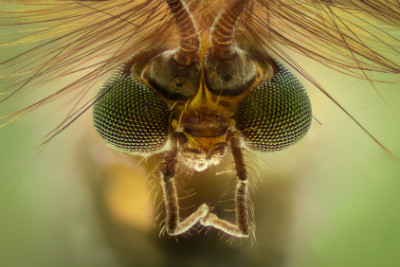The compound eye of arthropods is a model for designing specialised digital cameras.
Not for the first time scientists are copying what is found in nature to manufacture machines and instruments that are useful to us. A recent article entitled ‘Digital cameras with designs inspired by the arthropod eye’[1] details the work of scientists who have tried to design cameras based on arthropod eyes.
 Arthropod compound eyes are, to quote the authors: “uniquely sophisticated imaging systems”. This is because they have a very wide angle of view, low aberrations, high acuity to motion and infinite depth of field. They are hemispherical and have numerous light receiving ommatidia. Each Ommatidium consists of a cyclinder of cells capped by a lens with another optical apparatus just below this called the crystalline cone. These focus light onto the rhabdom. Here photosensitive pigments transmit electrical signals to nerves which travel to an optic ganglion. This is where the image is integrated from the mosaic of light that comes from all the lenses. The Ommatidia need to be precisely positioned on the surface. This means that each ommatidium must be exactly facing the correct angle. The angle in relation to other ommatidia must also be precise, as is the radius of the eye. As the authors state when trying to replicate these eyes using digital light receivers: “The dimensions and the mechanical properties of the imaging system are critically important for proper operation. The acceptance angle and the inter-ommatidial angle define the nature of the image.”
Arthropod compound eyes are, to quote the authors: “uniquely sophisticated imaging systems”. This is because they have a very wide angle of view, low aberrations, high acuity to motion and infinite depth of field. They are hemispherical and have numerous light receiving ommatidia. Each Ommatidium consists of a cyclinder of cells capped by a lens with another optical apparatus just below this called the crystalline cone. These focus light onto the rhabdom. Here photosensitive pigments transmit electrical signals to nerves which travel to an optic ganglion. This is where the image is integrated from the mosaic of light that comes from all the lenses. The Ommatidia need to be precisely positioned on the surface. This means that each ommatidium must be exactly facing the correct angle. The angle in relation to other ommatidia must also be precise, as is the radius of the eye. As the authors state when trying to replicate these eyes using digital light receivers: “The dimensions and the mechanical properties of the imaging system are critically important for proper operation. The acceptance angle and the inter-ommatidial angle define the nature of the image.”
The article describes how they have copied the arrangement using microlenses with photodiodes arrayed on a hemisphere. The electrical signals are collected and relayed by cable to a processor as in a digital camera.
The first eyes that are found in the fossil record are seen in the Cambrian Explosion of fauna 530 million years ago, when almost all our modern phyla (body plans) and many more, came into existence very suddenly. This rich fauna of complex sea dwelling animals included the Trilobite, one of the first arthropods. We have very fine fossils of the Trilobites from this time detailing the surface of their compound eyes. It is no exaggeration to say that it is a complete mystery as to how such complex visual systems ‘evolved’ suddenly with no evident precursors in the fossil record. There are no other animals in the now well searched strata that in any way show gradual evolution to the Trilobite eye.[2] It is not that soft bodied creatures failed to fossilise. On the contrary we do have plenty of fossils of the soft bodied organisms that came just before the Cambrian explosion, known as the Ediacaran fauna.[3]
Evolutionary theory fails to account for the appearance of such exquisite systems of vision appearing suddenly. Only with the most advanced engineering and electronic techniques along with teams of designers, can we even attempt to reproduce such an apparatus. To maintain that undirected, random genetic mistakes plus natural selection could produce these eyes, ‘in the blink of an eye’, is a position of faith which is against all the data we have from the fossil record.
References
[1] Song Y. M. et al. Digital cameras with designs inspired by the arthropod eye. Nature Vol 497. No. 7447. 104-107. 2 May 2013.
[2] For a great account see: Stephen Jay Gould, (1990). Wonderful Life. The Burgess Shale and the Nature of History. New York: Vantage,.
[3] For a detailed discussion on this see: Latham A. The Naked Emperor: Darwinism Exposed. Janus Publishing. 2005.
Image credit:
Thumbnail and article image - ConstantinCornel, Fotolia images
Antony Latham, 28/12/2016